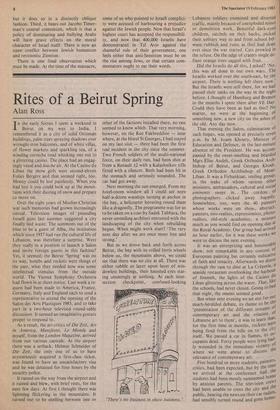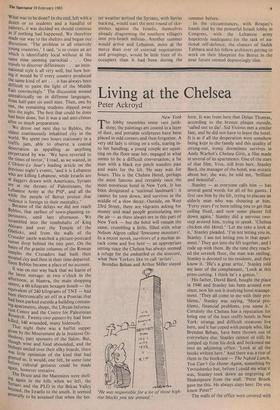Rites of a Beirut Spring
Alan Ross
In the early Sixties I spent a weekend in Beirut on my way to India. 1 remembered it as a city of solid Ottoman buildings, palm trees spraying shadows over wrought-iron balconies, and of white villas, of flower markets and sparkling sea, of a winding corniche road whisking one out to a glittering casino. The place had an engag- ingly venal and louche air. At the Casino du Liban the show girls were second-eleven Folies Bergere and that seemed right, too. Money could be lost painlessly. When you had lost it you could look up at the moun- tains with their dusting of snow and prepare to move on.
Over the eight years of Muslim-Christian war such memories had grown increasingly unreal. Television images of pounding Israeli guns last summer suggested a city finally laid waste. The summons out of the blue to be a guest of Alba, the institution which since 1937 had run the cultural life of Lebanon, was therefore a surprise. Were they really in a position to launch a Salon and invite foreign guests in this fashion? Yes, it seemed; the Beirut 'Spring' was on its way, bombs and rockets were things of the past, what they needed now was some intellectual stimulus from the outside world. The Vienna Symphony Orchestra had flown in at short notice. Last week a re- quest had been made to America, France, Germany, Italy and England each to send a representative to attend the opening of the Salon des Arts Plastiques 1983, and to take part in a two-hour televised round-table discussion. It seemed an imaginative gesture proper to respond to.
As a result, the art critics of Die Zeit, Art in America, Manifesto, Le Monde and myself, from the London Magazine, arrived from our various capitals. At the airport there was a setback. Helmut Schneider of Die Zeit, the only one of us to have mysteriously acquired a first-class ticket, was found to have an unsatisfactory visa and he was detained for four hours by the security police.
It rained on the way from the airport and it rained and blew, with brief rests, for the next few days. At first I thought there was lightning flickering in the mountains. It turned out to be shelling between one or other of the factions installed there, no one seemed to know which. That very morning, however, on the Rue Fakhreddine — near where, at the Hotel St Georges, I had stayed on my last visit — there had been the first real incident in the city since the summer. Two French soldiers of the multi-national force, on their daily run, had been shot at from a Renault 12 with a Kalashnikov rifle fitted with a silencer. Both had been hit in the stomach and seriously wounded. The car had got away.
Next morning the sun emerged. From my hotel-room window all I could see were half-a-dozen warships turning at anchor in the bay, a helicopter hovering round them like a dragonfly. The programme was for us to be taken on a tour by Sadek Tabbara, the never unsmiling architect entrusted with the landscaping of the city when rebuilding began. When might work start? 'The very next day after we are once more free and strong.'
But as we drove back and forth across Beirut, the bay with its stilled ferris wheels below us, the mountains above, we could see that there was no city at all. There was either rubble or layer upon layer of win- dowless buildings, their haunted eyes star- ing unseeingly at nothing. At each inter- section checkpoint, confused-looking `There's no business in show business.' Lebanese soldiers examined and diverted traffic, mainly because of unexploded mines or demolition work. Beautiful dark-eyed children, satchels on their backs, picked their solitary way to and from school bet- ween rubbish and ruins as they had done ever since the war started. Cats prowled in the refuse. On the edge of craters single de- fiant orange trees sagged with fruit.
Did the Israelis do all this, I asked? `No, this was all done in our own wars. The Israelis worked over the south-east, by the airport. There is nothing left there now.' But the Israelis were still there, for we had passed their tanks on the way in the night
before. I thought of Hamburg and Bremen in the months I spent there after VE Day.
Could they have been as bad as this? No matter, we were at the beginning of something new, a new city on the ashes of the old. Any day now. That evening the Salon, culmination of such hopes, was opened at precisely seven p.m. by M. Issam Khoury, Minister of
Education and Defence, in the last-minute absence of the President. He was accom-
panied by the sweet-smelling and bearded
Mgrs Elias Audeh, Greek Orthodox Arch- bishop of Beirut, and Georges Khodr,
Greek Orthodox Archbishop of Mont'
Liban. It was a Firbankian, smiling group, in the wake of whom various other
ministers, ambassadors, cultural and social
eminents swept in. The cordon of photographers clicked away happilY.
Somewhere, too, were the 40 painters
whose works were on show, abstract, painters, neo-realists, expressionists, photo-
realists, old-style academics, a mixture much as you would find on opening day at the Royal Academy. Our group had arrived an hour earlier, for it was these works We were to discuss the next evening.
It was an enterprising and honourable show, not remarkable in any context .of
European painting but certainly indicat we
of faith and tenacity. Afterwards we drove through the rain to dine at La Creperie, a seaside restaurant overlooking the harbour of Jounieh, the lights of the Casino du Liban glittering across the water. That, like the schools, had never closed. Going to be that night, the omens seemed good. But when next evening we set out for our much-heralded debate, its theme to be the,,
`presentation of the different streams of contemporary art and the relation of Lebanese art to them', it was to learn that,
for the first time in months, rockets were being fired from the hills on to the 0°' itself. We passed a car in flames, its oc- cupants dead. Forty people were lying bad- ly wounded in the immediate vicinity 01 where we were about to discuss the relevance of contemporary art. Five hundred or more students, painters, critics, had been expected, but by the time we arrived at the conference hall the
students had been mostly summoned home by anxious parents. The television crews
had been unable to cross the city and the public, hearing the news on their car radios, had sensibly turned round and gone home. What was to be done? In the end, left with a dozen or so students and a handful of Painters, it was decided we should continue as if nothing had happened. We therefore made ow- way to the shelters and began our discussion. 'The problem in all relatively Young countries,' I said, 'is to create an art which is identifiably local without at the same time seeming parochial . . . One travels to discover differences . . . an inter- national style is all very well, but how bor- ing it would be if every country produced the same kind of art . . . it has always been difficult to paint the light of the Middle East convincingly.' The discussion wound unrealistically on in different languages, from half-past six until nine. Then, one by one, the remaining students slipped away Into the night. The best that could be done had been done, but it was a sad anti-climax after so much preparation.
We drove out next day to Byblos, the oldest continuously inhabited city in the world. We spent two hours stationary in a traffic jam, able to observe a coastal desecration as appalling as anything Perpetrated by war. 'We have reverted to the times of terror,' 1 read, as we waited, in L'Orient-Le Jour's leading article on the previous night's events, 'and it is Lebanese who are killing Lebanese, while Israelis are at daggers drawn with Americans, Syrians are at the throats of Palestinians, the Lebanese Army at the PSP, and all the While the people of Beirut protest that violence is foreign to their mentality.' Because of the delays we did not reach RYblos, that earliest of town-planning ex- periments, until late afternoon. We scrambled into the tombshafts of King Ahiram and over the Temple of the Obelisks, and from the walls of the Crusader castle watched a picture-postcard sunset drop behind the tiny port. On the bases of the granite columns of the Roman temples the Crusaders had built their 'boated city and then in their time departed. Soon Byblos became a place of no account. , It was on our way back that we learnt of the latest outrage: at two o'clock in the afternoon, at Hamra, the main shopping Centre, a 60-kilogram hexagen bomb — the equivalent of 240 kilograms of TNT — had been electronically set off in a Pontiac that had been parked outside a building contain- ing apartments, shops, the Libyan Informa- tion
Centre and the Centre for Palestinian
Research. Twenty-two passers-by had been killed, 140 wounded, many hideously. That night there was a buffet supper given by the Mouvement de la Jeunesse Or- ,t,,h°dbxe, part sponsors of the Salon. But, ,"1gh wine and food abounded, and the uishops smiled over their silky beards, there was little optimism of the kind that had greeted us. It would, one felt, be some time before cultural gestures could be made again, however tentative.
The Druse and the Maronites were shell-
ing in the hills when we left, the Syrians and the PLO in the Bekaa Valley beyond, the Israelis to the south. It seemed generally to be assumed that when the bet-
ter weather arrived the Syrians, with Soviet backing, would start the next round of skir- mishes against the Israelis, themselves already dragooning the southern villagers into pro-Israeli militias. Another summer would arrive and Lebanon, more at the mercy than ever of external negotiations and groupings, would be little freer of its occupiers than it had been during the summer before.
In the circumstances, with Reagan's hands tied by the powerful Israeli lobby in Congress, with the Lebanese army hopelessly inadequate for the task of na- tional self-defence, the chances of Sadek Tabbara and his fellow architects getting to work on their blueprint for Beirut in the near future seemed depressingly slim.







































 Previous page
Previous page